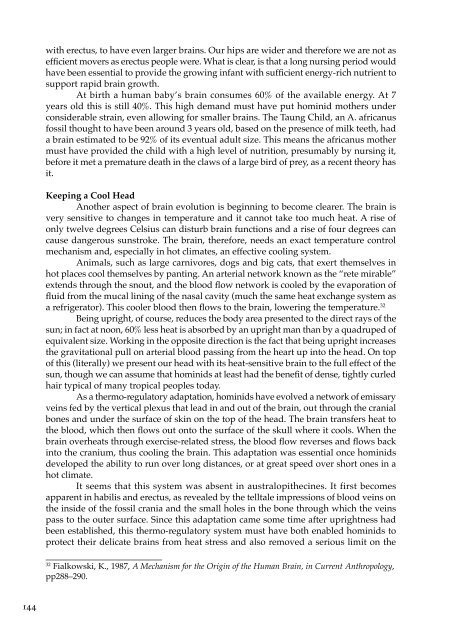The Spirit in Human Evolution - Waldorf Research Institute
The Spirit in Human Evolution - Waldorf Research Institute
The Spirit in Human Evolution - Waldorf Research Institute
You also want an ePaper? Increase the reach of your titles
YUMPU automatically turns print PDFs into web optimized ePapers that Google loves.
with erectus, to have even larger bra<strong>in</strong>s. Our hips are wider and therefore we are not as<br />
efficient movers as erectus people were. What is clear, is that a long nurs<strong>in</strong>g period would<br />
have been essential to provide the grow<strong>in</strong>g <strong>in</strong>fant with sufficient energy-rich nutrient to<br />
support rapid bra<strong>in</strong> growth.<br />
At birth a human baby’s bra<strong>in</strong> consumes 60% of the available energy. At 7<br />
years old this is still 40%. This high demand must have put hom<strong>in</strong>id mothers under<br />
considerable stra<strong>in</strong>, even allow<strong>in</strong>g for smaller bra<strong>in</strong>s. <strong>The</strong> Taung Child, an A. africanus<br />
fossil thought to have been around 3 years old, based on the presence of milk teeth, had<br />
a bra<strong>in</strong> estimated to be 92% of its eventual adult size. This means the africanus mother<br />
must have provided the child with a high level of nutrition, presumably by nurs<strong>in</strong>g it,<br />
before it met a premature death <strong>in</strong> the claws of a large bird of prey, as a recent theory has<br />
it.<br />
Keep<strong>in</strong>g a Cool Head<br />
Another aspect of bra<strong>in</strong> evolution is beg<strong>in</strong>n<strong>in</strong>g to become clearer. <strong>The</strong> bra<strong>in</strong> is<br />
very sensitive to changes <strong>in</strong> temperature and it cannot take too much heat. A rise of<br />
only twelve degrees Celsius can disturb bra<strong>in</strong> functions and a rise of four degrees can<br />
cause dangerous sunstroke. <strong>The</strong> bra<strong>in</strong>, therefore, needs an exact temperature control<br />
mechanism and, especially <strong>in</strong> hot climates, an effective cool<strong>in</strong>g system.<br />
Animals, such as large carnivores, dogs and big cats, that exert themselves <strong>in</strong><br />
hot places cool themselves by pant<strong>in</strong>g. An arterial network known as the “rete mirable”<br />
extends through the snout, and the blood flow network is cooled by the evaporation of<br />
fluid from the mucal l<strong>in</strong><strong>in</strong>g of the nasal cavity (much the same heat exchange system as<br />
a refrigerator). This cooler blood then flows to the bra<strong>in</strong>, lower<strong>in</strong>g the temperature. 32<br />
Be<strong>in</strong>g upright, of course, reduces the body area presented to the direct rays of the<br />
sun; <strong>in</strong> fact at noon, 60% less heat is absorbed by an upright man than by a quadruped of<br />
equivalent size. Work<strong>in</strong>g <strong>in</strong> the opposite direction is the fact that be<strong>in</strong>g upright <strong>in</strong>creases<br />
the gravitational pull on arterial blood pass<strong>in</strong>g from the heart up <strong>in</strong>to the head. On top<br />
of this (literally) we present our head with its heat-sensitive bra<strong>in</strong> to the full effect of the<br />
sun, though we can assume that hom<strong>in</strong>ids at least had the benefit of dense, tightly curled<br />
hair typical of many tropical peoples today.<br />
As a thermo-regulatory adaptation, hom<strong>in</strong>ids have evolved a network of emissary<br />
ve<strong>in</strong>s fed by the vertical plexus that lead <strong>in</strong> and out of the bra<strong>in</strong>, out through the cranial<br />
bones and under the surface of sk<strong>in</strong> on the top of the head. <strong>The</strong> bra<strong>in</strong> transfers heat to<br />
the blood, which then flows out onto the surface of the skull where it cools. When the<br />
bra<strong>in</strong> overheats through exercise-related stress, the blood flow reverses and flows back<br />
<strong>in</strong>to the cranium, thus cool<strong>in</strong>g the bra<strong>in</strong>. This adaptation was essential once hom<strong>in</strong>ids<br />
developed the ability to run over long distances, or at great speed over short ones <strong>in</strong> a<br />
hot climate.<br />
It seems that this system was absent <strong>in</strong> australopithec<strong>in</strong>es. It first becomes<br />
apparent <strong>in</strong> habilis and erectus, as revealed by the telltale impressions of blood ve<strong>in</strong>s on<br />
the <strong>in</strong>side of the fossil crania and the small holes <strong>in</strong> the bone through which the ve<strong>in</strong>s<br />
pass to the outer surface. S<strong>in</strong>ce this adaptation came some time after uprightness had<br />
been established, this thermo-regulatory system must have both enabled hom<strong>in</strong>ids to<br />
protect their delicate bra<strong>in</strong>s from heat stress and also removed a serious limit on the<br />
_________________________<br />
32<br />
Fialkowski, K., 1987, A Mechanism for the Orig<strong>in</strong> of the <strong>Human</strong> Bra<strong>in</strong>, <strong>in</strong> Current Anthropology,<br />
pp288–290.<br />
144
















